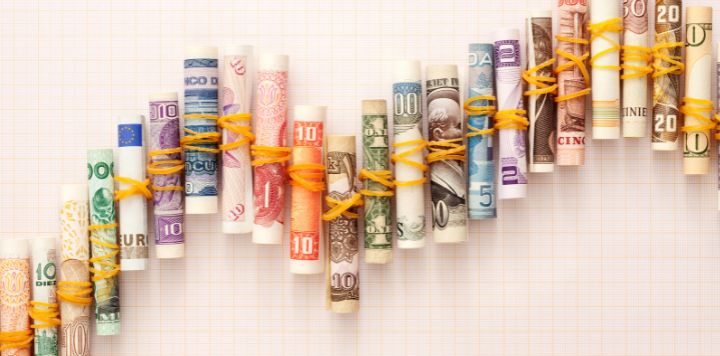Summary: Foreign exchange rates are influenced by various factors, and knowing them can help you make smarter decisions and secure the best rates. Continue reading to know more about the key drivers behind rate fluctuations and how popular currencies have fluctuated over time.
Exchange rates play a critical role when it comes to the global economy, influencing everything from the stock market to international travel. In this blog, let’s understand the concept of exchange rates, the factors causing their fluctuations, the historical performance of major currencies, and the impact of these fluctuations on various aspects of the economy.
What Are Exchange Rates?
An exchange rate is the value of one country’s currency with respect to another currency. Exchange rates are viewed as the value of one currency in relation to another. For example, the exchange rate between the US Dollar (USD) and the Indian Rupee (INR) tells you how many Indian Rupees you need to buy one US Dollar. The USD to INR exchange rate is 83.98 (as of 11th September 2024), meaning 1 United States Dollar equals 83.98 Indian Rupee.
Let’s assume you’re traveling from India to the USA and want to carry ₹2,00,000 for your trip, you’ll need to convert it to dollars. Assuming the current exchange rate is 83.98, this means ₹2,00,000 will be equivalent to approximately $2381. Here’s the calculation:
₹2,00,000 ÷ 83.98 = $2381
Now let’s assume you have $100 remaining after your trip and the exchange rate has changed to 83.28, converting this amount back to INR will give you ₹67,32. The calculation is:
$100 × 83.28 = ₹8328
Note that the exchange rate between any two currencies is determined through multiple factors such as interest rates, economic reasons, GDP, and the unemployment rate. Also, the strength or weakness of a currency greatly affects its international trade, and tourism sector, as well as the cost of imported goods.
Types of Exchange Rate Systems
There are two main types of exchange rate systems:
1. Floating Exchange Rate: Determined by market forces of supply and demand. It fluctuates based on economic conditions, geopolitical events, and investor sentiments.
2. Fixed Exchange Rate: Pegged to another major currency or a basket of currencies. Central banks intervene to maintain the rate within a narrow band.
Most exchange rates are floating in nature and their values rise or fall on the basis of supply and demand in the foreign exchange market.
What Are Fluctuations in Exchange Rate?
Fluctuations in exchange rates refer to the changes in the value of a currency relative to another over time. These changes can be minor or substantial, depending on various factors such as economic indicators, political stability, and market speculation.
There are multiple factors responsible for the foreign exchange fluctuations. For example, a currency’s value might rise or fall due to international trading, policy decisions, investor expectations, the political climate, and the overall economic conditions of a country. Let’s understand the factors responsible for foreign exchange rate fluctuations in more detail.
Factors Influencing the Fluctuation of Exchange Rates
Significant fluctuations in exchange rates can encourage or discourage foreign tourism and investment in a country. Here are some of the most common factors influencing the currency exchange fluctuations:
1. Inflation: It is one of the key factors influencing foreign exchange fluctuations. When a country faces high inflation, its currency loses purchasing power, making it less appealing to investors. This decline in demand results in the currency’s devaluation. Conversely, in countries with low inflation, the currency retains more value, potentially attracting more investment and driving up its value.
2. Recession: Economic recessions can greatly influence exchange rates. During a recession, the economy contracts, and interest rates typically fall, leading to reduced consumer spending. This can weaken the country’s currency. In contrast, when an economy is expanding, it is seen as more stable and secure, attracting investors and strengthening the currency.
3. Interest Rates: They are another major driver of exchange rate movements. When a country raises its interest rates, it tends to attract foreign investors seeking higher returns, boosting the demand for its currency and raising its value. On the other hand, lower interest rates may deter investment, decreasing demand for the currency and leading to a fall in its value.
4. Investor Assumptions: Speculation by investors also plays a significant role in currency exchange fluctuations. If investors believe a country’s economy will grow, they may purchase its currency, increasing its value. Conversely, if they anticipate economic decline, they may sell the currency, causing its value to drop.
5. Stock Markets: Stock market performance can impact exchange rates as well. A booming stock market tends to attract foreign investment, which boosts demand for the country’s currency and increases its value. If the stock market is underperforming, foreign investors may pull out, leading to reduced demand and a decline in currency value.
6. Political Stability: Political stability is crucial for maintaining a strong currency. A stable government boosts investor confidence, thereby supporting a stronger currency. However, political instability can create uncertainty, negatively impacting investor confidence and leading to a decrease in the currency’s value.
7. Government Debt: High levels of government debt can negatively affect exchange rates. Excessive debt raises concerns among investors, who may view the country as a riskier investment, leading to decreased demand for its currency and a drop in value.
8. Current Account Deficits: A current account deficit occurs when a country imports more than it exports, leading to a net outflow of money. This can reduce demand for the currency, as the reliance on imports can make it less attractive to investors.
9. Terms of Trade: The terms of trade, which compare export prices to import prices, can also influence exchange rates. If a country’s terms of trade improve, meaning it earns more from exports than it spends on imports, demand for its currency increases, pushing its value higher.
How Popular Foreign Currencies Have Fluctuated Over Time
Currency values fluctuate constantly due to various factors. Here’s a brief overview of how the USD, EUR, INR, and GBP have performed over time:
1. USD Fluctuation
The U.S. dollar was introduced in 1792 and has been impacted by many factors including the adoption and eventual abandonment of the gold standard. Other key events that have influenced the US dollar fluctuations include the 1907 Bankers’ Panic, the 1929 Stock Market Crash and the Great Depression, the stock market bubble of the 1980s, and numerous wars. The 9/11 attacks, the “dot-com” bubble of 2001, the 2008 financial crisis, and the COVID-19 pandemic have also played major roles in the dollar’s fluctuations.
The U.S. Dollar Index, which tracks the dollar’s value against a basket of other currencies, reached its all-time high of 164.72 in 1985, around the time of the Plaza Accord when global finance ministers worked to manage fluctuating exchange rates. The dollar reached its all-time low of 70.698 during the 2008 financial crisis, alongside major U.S. government legislation aimed at stabilizing the economy. In September 2022, the index hit a 20-year high of 110.05 as the world emerged from the COVID-19 pandemic and interest rates rose.
2. GBP Fluctuation
The British pound has a long history spanning centuries, and its value has been shaped by various key events. Significant milestones include the adoption of the gold standard in the 18th and 19th centuries and its subsequent abandonment and reintroduction throughout the 20th century. In more recent times, the pound’s value has experienced sharp fluctuations due to events like Black Wednesday in 1992, the rise of the euro in 1999, and the Brexit vote in 2016.
In September 2022, the pound hit an all-time low against the U.S. dollar, valued at just $1.03 following the UK government’s introduction of significant tax cuts. However, the pound has also seen its peaks, with values often exceeding $2.50 in the past. Its highest value occurred during the U.S. Civil War in the 1800s when the pound was worth approximately $10.00.
3. EUR Fluctuation
Though the euro is much newer than the USD or GBP, having been introduced in 1999, it has experienced several major fluctuations. At launch, €1.00 was worth approximately $1.17, but by the end of 1999, the euro had reached parity with the U.S. dollar. The euro’s value continued to decline, hitting its all-time low of $0.82 in the year 2000.
Since then, the euro has seen numerous ups and downs due to European Central Bank policies and other global events. It reached its all-time high in 2008, valued at $1.60, during the U.S. financial crisis and the European Central Bank’s own interest rate hikes.
4. INR Fluctuation
The Indian Rupee has experienced considerable fluctuations due to various factors. One of the significant events in history was the 1991 economic crisis, which led to a major devaluation of the rupee. In more recent times, the INR has been influenced by the global financial crisis of 2008 and the demonetization policy of 2016, which involved the withdrawal of high-denomination currency notes. Despite this, the INR has seen periods of appreciation in the past, reaching higher values against other currencies due to various factors including strong economic growth and favorable trade balances.
Impact of Exchange Rate Fluctuations
1. On Economy: Currency depreciation can lead to higher import prices, contributing to inflation. Conversely, currency appreciation can lower import costs.
2. On Stock Market: Currency fluctuations can influence investor confidence and market volatility. A stable currency generally promotes a more predictable investment environment.
3. On International Travel: Exchange rate fluctuations affect the cost of traveling abroad. A stronger domestic currency means travelers can enjoy more value for their money. Conversely, a weaker currency makes travel more expensive.
Keep Track of Exchange Rate Fluctuations With Rate Alert Feature
Staying on top of exchange rate fluctuations can be challenging. Fortunately, BookMyForex offers a solution to help you manage your currency exchange needs with ease with our “Rate Alert” feature. This feature is designed to keep you informed about exchange rate changes, ensuring you never miss an opportunity to secure the best rates for your forex transactions.
Whether you’re planning an international trip, sending money overseas, or simply looking to make the most of favorable exchange rates, our “Rate Alert” feature keeps you updated in real-time.
FAQs
1. What is the concept of exchange rate fluctuations?
Exchange rate fluctuations refer to the changes in the value of one currency relative to another over time. These fluctuations occur due to various economic, political, and market reasons.
2. How often do exchange rates fluctuate?
Exchange rates can fluctuate frequently, sometimes even within the same day, depending on market conditions and economic events.
3. How do you overcome exchange rate fluctuations when traveling abroad?
International travelers can use multi-currency forex cards to lock in exchange rates before traveling, avoiding rate fluctuations during their trips.
4. How do exchange rate fluctuations affect imports and exports?
Fluctuations can impact the cost of imports and exports. A weaker currency makes exports cheaper and imports more expensive, while a stronger currency has the opposite effect.
5. Can exchange rate fluctuations affect my investments?
Yes, fluctuations can impact the returns on investments in foreign assets or companies that operate internationally.





























Leave a Reply